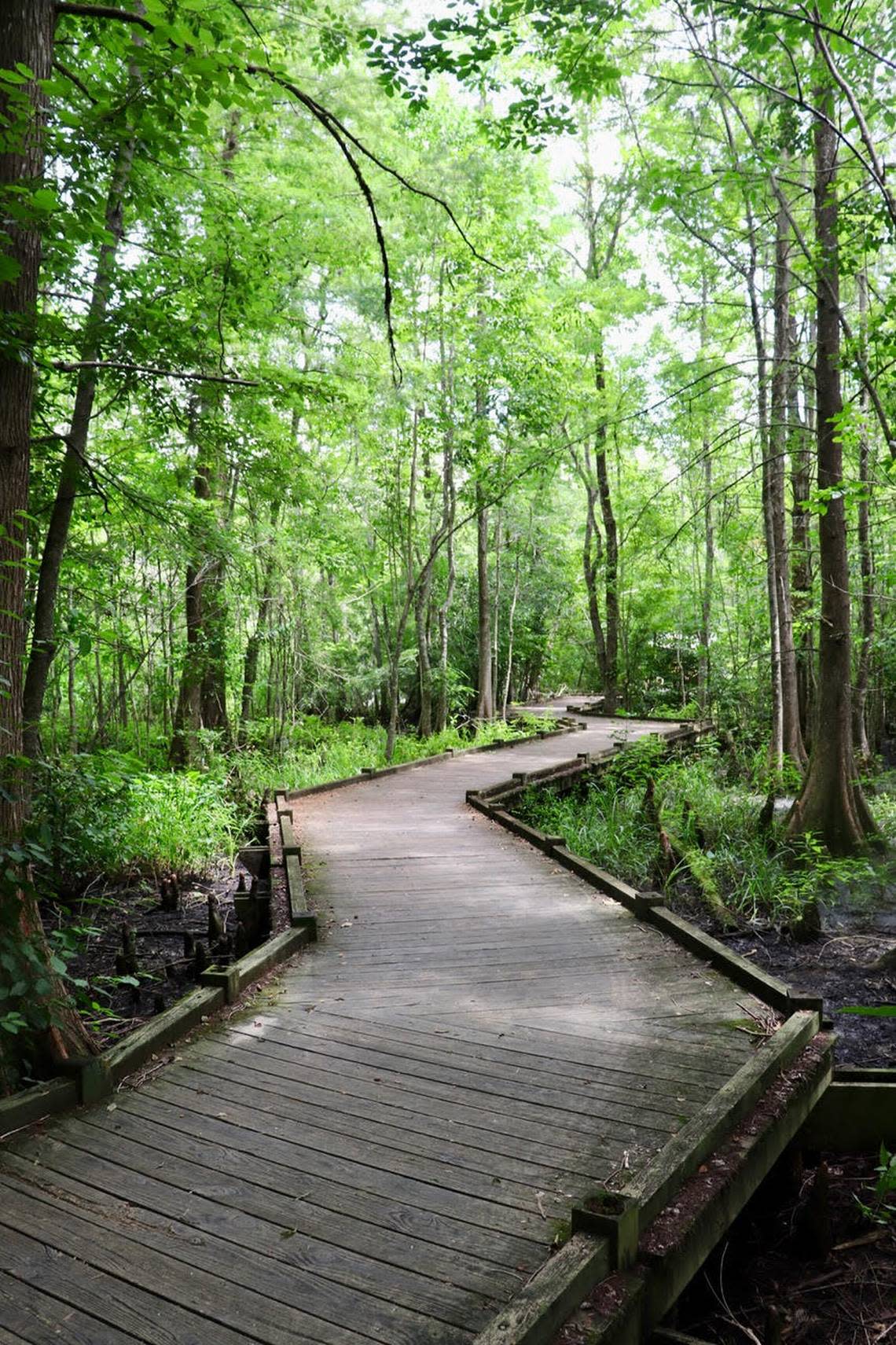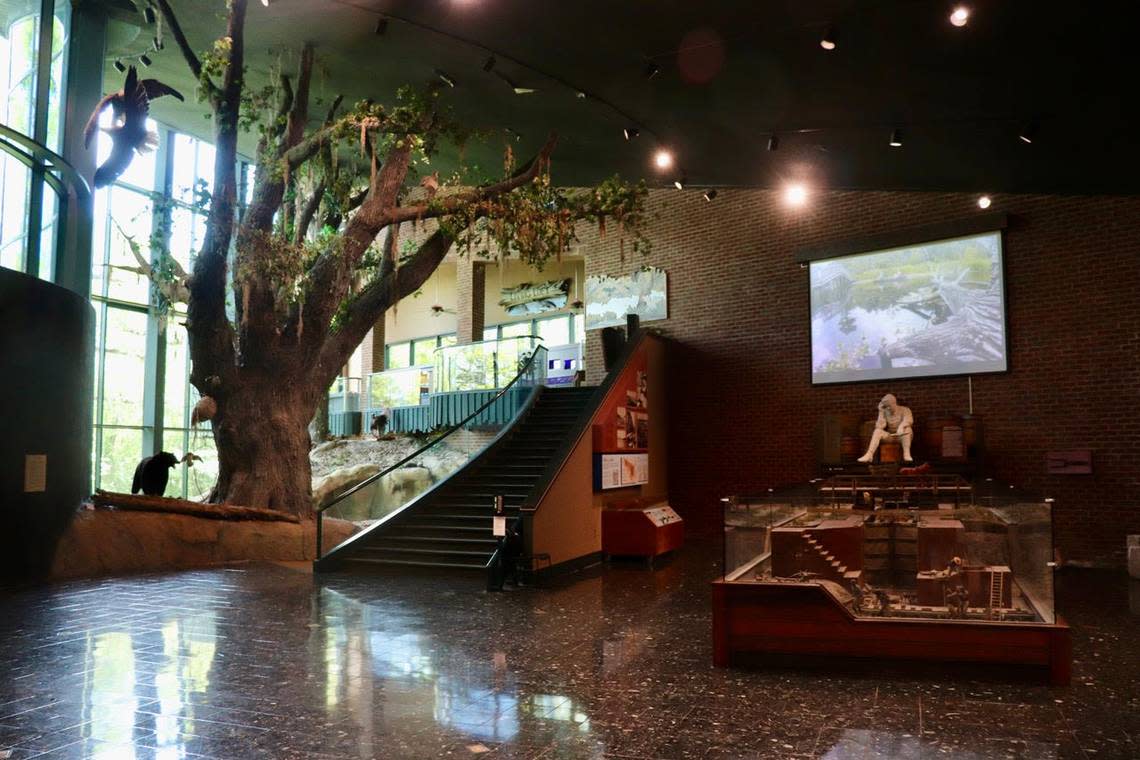Old Santee Canal Park is a quiet oasis where nature and history can be explored together
During a day trip to Old Santee Canal Park in Moncks Corner, north of Charleston, it’s not difficult to imagine life in the Lowcountry as it was 200 years ago: A swampy creek bordered by cypress trees, alligators cruising through black water, egrets wading in the shallows, and frogs croaking from behind a curtain of rustling marsh grass.
All that is missing is a long, slender wooden flatboat filled with barrels of molasses, sacks of cornmeal and bales of cotton, being poled along toward the spires of the city of Charleston in the distance.
Old Santee Canal Park in Moncks Corner preserves 195 acres surrounding Biggin Creek, a swampy waterway that was once the site of America’s first summit-level canal that was an engineering marvel of its day.
Backed by business leaders and some of the most famous names in colonial South Carolina — including Revolutionary War generals such as William Moultrie, Francis Marion and Thomas Sumter, and eminent figures such as John Rutledge, signer of the U.S. Constitution — the Santee Canal was an ambitious project. The canal, stretching 22 miles connected the Cooper River in Charleston with the Santee River and opened a waterway of trade to Columbia and the heart of the Carolinas.
Begun in 1793, under the direction of Lt. Col. Christian Senf, a Swedish or Danish-born engineer who had saved with the patriot army, the Santee Canal took nearly a decade to build and at its height employed over 1,000 laborers, many of whom were indentured slaves. The canal used a series of locks, built of hand-made brick, to raise and lower flatboats over a 35-foot elevation change between the Santee and Cooper rivers.
Farmers and traders from the midlands to the mountains could more easily sell their goods in Charleston, and merchants there could ship their wares far inland. Despite its success, the Santee Canal was soon overtaken by railroads and this new technology rendered it obsolete.

A section of the Santee Canal is preserved at Old Santee Canal Park in Moncks Corner, and when you visit today, you will be fascinated by the unique history, and amazed at the natural beauty of the park. When you arrive you will encounter the 11,000-square-foot interpretive center, the entrance to which is a replica of an old canal lock.
Inside, the well-maintained building houses a museum outlining the history of the canal, the technology behind its construction and the cultural impact of its success. The natural world is celebrated, too, as a giant live oak highlights the oak bluff ecosystem surrounding the park, and live examples of Lowcountry wildlife can be viewed.
There are guided tours, educational programs and special events held year-round that make Old Santee Canal Park a facet of culture that benefits young and old alike.

Outside, more than four miles of boardwalks and trails crisscross Biggin Creek and the swampy canal trace. Wildlife abounds and can be easily seen from well-sited viewing areas.
Canoes and kayaks are available to explore the waterway, too. While watercraft speed by in the nearby Tailrace Canal, life in Old Santee Canal Park remains a quiet oasis where nature and history can be explored together. This history also includes nearby Stony Landing and the 1843 plantation house that still sits high on the bluff over the river it once served.
Here was a hub of trade from colonial times and during the Civil War it became known for another important role: The small semisubmersible “Little David” was built, and armed with a torpedo, was sent against the Union fleet blockading Charleston. There it successfully damaged a Union ironclad and made history.

A replica of the “Little David” can be seen on the grounds of Old Santee Canal Park at the Berkeley County Museum, and inside the park’s interpretive center.
For a day of adventure through history, a glimpse at a fascinating technology of the past, and a walk on the wild side, Old Santee Canal Park in Moncks Corner is well-worth a visit.
Getting There
Old Santee Canal Park in Moncks Corner in Berkeley County is located at 900 Stoney Landing Road., is just under two hours from the Beaufort area and very easy to find.
Take U.S. 17 toward Charleston to Ravenel and turn left onto S.C. 165. Take 165 to Summerville and take a right onto U.S. 17A toward Moncks Corner. In Moncks Corner, turn right onto Mountain Pine Road and turn left at U.S. 52. Follow the signs to Old Santee Canal Park and turn right onto Stoney Landing Road.
Old Santee Canal Park is open year-round from 9 a.m. to 5 p.m. Admission is $5 per person, $3 for seniors and children under 6 free. Guided tours and group rates are available and there are numerous educational and cultural programs throughout the year.
For more information on Old Santee Canal Park, call 843-899-5200 or visit https://www.oldsanteecanalpark.org
